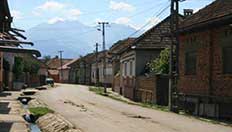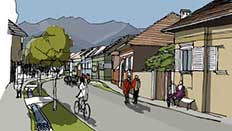Făgăraş 'Atelier de urbanism
'Atelier de Urbanism' - Drăguș Village Workshop
Introduction and purpose of the Atelier
The 'Atelier de Urbanism' (Urbanism Workshop) was held in the village of Drăguș in Brașov County and in the hinterland of the town of Făgăraș, an historic town in the Carpathian Mountains of Transylvania. The Atelier was initiated by Mihai Racu and a group of Romanian urbanists and was held over 6 days in 2014, but a great deal of preparatory work was undertaken before the workshop itself.
The purpose of this second Atelier in a 3 workshop series was to continue to explore urbanism issues in and around the town of Făgăraș. This atelier expanded the scope outwards spatially from the original focus on urbanism issues in Făgăraș itself, to consider the uncertainties facing the nearby rural village of Drăguș and its hinterland which is close to the high Făgăraș mountain areas including ski fields and a much visited pilgrimage site, the Brancoveanu Monastery.
The aim was to look at design-based interventions to support the place's economic and cultural life in a sustainable way. Participants included urban designers, architects (students and practitioners), sociologists, gastronomers, NGO representatives and community and municipal stakeholders.


Fig 1 Typical Drăguș village streetscape – before renovation. Photograph: Mihai Racu
Fig 2 Drăguș streetscape after proposed renovations. Illustration by Klaus Birthler
The background
Like all villages in Transylvania, Drăguș is facing a range of urbanism issues and architectural issues should be one focus for the workshop. Opportunities related to rapid cultural, economic and demographic change. The village still has a thriving agricultural base, the area is famous for growing extremely good potatoes. There is local dairying on shared pastures, and households are able to be semi-self sufficient in food from numerous kitchen gardens, orchards and domestic animal keeping.
As 'ageing in place' occurs, and many younger villagers leave for alternative destinations to find employment, they bring or send back resources to 'fix up' houses and build new ones. Additionally, new guest houses are being built or retrofitted from village houses to cater for the currently small but increasing numbers of tourists: some to visit the nearby monastery, others to enjoy outdoor pursuits in the Drăguș mountains and their ski-‐fields.
However, these new and renovated buildings do not always respect the design and aesthetic qualities of existing coherent townscapes and can sometimes undermine them. It was apparent that attention to these architectural issues should be one focus for the workshop.
The process
The work started with briefings and site visits through which the team sought to better understand the way of life of the place. One fascinating aspect was the chance to see the inter-war work of the pioneering Romanian sociologist and ethnographer, Dimitrie Gusti, who, with a large team, recorded aspects of village life and culture.
The team also explored the place on a series of walks and briefing sessions with local experts and heard from a range of stakeholders including local politicians, planners and other community representatives about life in the village and its current issues. Another important aspect was the integration of gastronomy and local gastronomers prepared food characteristics of Drăguș, and local foodspaces along the food chain from production and exchange to consumption.
Based at the local government offices in the village centre, the Atelier team worked intensively to explore and identify various salient aspects of the village's urbanism; including the nature of its public spaces, streetscapes, green landscapes, public and domestic architecture, and its productive edges, which are beginning to experience the first tendencies towards sprawl (a problem also increasingly evident closer to the deep mountains).
As in normal charrette practice, using transect based approaches, the team drew up design options for various village areas; proposing a range of possible retrofitting and sprawl repair actions. Before and after visualisations were used to help explain the possibilities to stakeholders (see indicative illustration by Klaus Birthler).
Design outcomes
This work produced an architectural guide to Drăguș housing (the 'Casele caracteristice Drăgușului') to help those wishing to renovate or alter their houses. A guide to specific design and architectural information was created to help renovators and new builders reflect vernacular traditions. This included materials, proportions, and composition of facades and other housing elements. It is pleasing to note that the architectural guide is now being used in the village.